|
|
|
Sort Order |
|
|
|
Items / Page
|
|
|
|
|
|
|
| Srl | Item |
| 1 |
ID:
094964


|
|
|
|
|
| Publication |
2010.
|
| Summary/Abstract |
Lignocellulosic biomass is expected to become a key feedstock for renewable energy production. However, the potential supply strongly depends on farmers' willingness to grow the new perennial energy crops. Many economic assessments have been led at the farm level, all based on the standard net present value approach. This paper looks into the effect of farmers' liquidity constraints and risk preferences on switchgrass and miscanthus adoption by farmers. We study the problem of the land allocation between a traditional cropping system and an innovative one in a static framework, using four intertemporal choice models. We find that, in central France agronomic and economic conditions, switchgrass and miscanthus result to be less profitable in terms of annualised net margin than the usual rape/wheat/barley rotation. Nevertheless, they can be highly competitive as diversification crops when appropriate contracts are offered to farmers, despite the additional liquidity they require.
|
|
|
|
|
|
|
|
|
|
|
|
|
|
|
|
| 2 |
ID:
094905
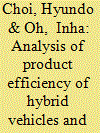

|
|
|
|
|
| Publication |
2010.
|
| Summary/Abstract |
The key aim of this study is to evaluate the product efficiency of current hybrid vehicles and suggest effective policies to promote hybrid vehicles in the Korean automobile market and development trends of hybrid vehicles. The efficiency levels for car models sold in Korea, including hybrid ones, were measured using the recently developed discrete additive data envelopment analysis (DEA) model that reflects consumer preference. The result of the analysis shows that current hybrid vehicles on the market are still at lower competitive advantage than traditional car models with conventional combustion engines and we can suggest a mix of incentive policies to promote the competitiveness of hybrid vehicles. In addition, we also identify two distinctive trends of hybrid vehicle development: environment-oriented hybrid vehicles and performance-oriented hybrid vehicles. It implies that the government should take account of development trends of hybrid vehicles to achieve the policy goals in designing support schemes and automobile companies that are willing to develop hybrid vehicles can also gain some insights for making strategic decisions.
|
|
|
|
|
|
|
|
|
|
|
|
|
|
|
|
| 3 |
ID:
094940
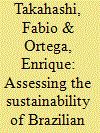

|
|
|
|
|
| Publication |
2010.
|
| Summary/Abstract |
The aim of this paper is to make an emergy assessment of oleaginous crops cultivated in Brazil, available to produce biodiesel, in order to determine which crop is the most sustainable. This study evaluates conventional agro-chemical farms that produce rapeseed (canola), oil palm, soybean, sunflower and cotton. Rapeseed (canola) crop uses 40.41% of renewable energy and it is the most sustainable conventional oil crop; on the other hand, it is not widely produced in Brazil, probably due to climate restrictions or low market demand. The oil palm emergy indicators are contradictory: its emergy exchange ratio (EER) value is the lower, showing the possibility of fair exchange, and the low transformity value indicates high efficiency; however, it also has low renewability (28.31%), indicating a high dependency on agro-chemicals (basically fertilizers). Oil palm is a potential energy source due to its high agricultural productivity, but appropriate management is necessary to increase its sustainability and reduce the use of non-renewable resources.
|
|
|
|
|
|
|
|
|
|
|
|
|
|
|
|
| 4 |
ID:
094904


|
|
|
|
|
| Publication |
2010.
|
| Summary/Abstract |
This paper illustrates a new method to create supply curves for pollution abatement using boiler-level data that explicitly accounts for technology cost and performance. The Coal Utility Environmental Cost (CUECost) model is used to estimate retrofit costs for five different NOx control configurations on a large subset of the existing coal-fired, utility-owned boilers in the US. The resultant data are used to create technology-specific marginal abatement cost curves (MACCs) and also serve as input to an integer linear program, which minimizes system-wide control costs by finding the optimal distribution of NOx controls across the modeled boilers under an emission constraint. The result is a single optimized MACC that accounts for detailed, boiler-specific information related to NOx retrofits. Because the resultant MACCs do not take into account regional differences in air-quality standards or pre-existing NOx controls, the results should not be interpreted as a policy prescription. The general method as well as NOx-specific results presented here should be of significant value to modelers and policy analysts who must estimate the costs of pollution reduction.
|
|
|
|
|
|
|
|
|
|
|
|
|
|
|
|
| 5 |
ID:
094962


|
|
|
|
|
| Publication |
2010.
|
| Summary/Abstract |
China has undertaken the greatest number of projects and reported the largest emission reductions on the global clean development mechanism (CDM) market. As technology transfer (TT) was designed to play a key role for Annex II countries in achieving greenhouse gas emission reductions, this study examines various factors that have affected CDM and TT in China. The proportion of total income derived from the certified emissions reductions (CER) plays a key role in the project owners' decision to adopt foreign technology. Incompatibility of CDM procedures with Chinese domestic procedures, technology diffusion (TD) effects, Chinese government policy and the role of carbon traders and CDM project consultants all contribute to the different degrees and forms of TT. International carbon traders and CDM consultants could play a larger role in TT in China's CDM projects as investors and brokers in the future.
|
|
|
|
|
|
|
|
|
|
|
|
|
|
|
|
| 6 |
ID:
094954


|
|
|
|
|
| Publication |
2010.
|
| Summary/Abstract |
Wind turbines are favoured in the switch-over to renewable energy. Suitable sites for further developments could be difficult to find as the sound emitted from the rotor blades calls for a sufficient distance to residents to avoid negative effects. The aim of this study was to explore if road traffic sound could mask wind turbine sound or, in contrast, increases annoyance due to wind turbine noise. Annoyance of road traffic and wind turbine noise was measured in the WINDFARMperception survey in the Netherlands in 2007 (n=725) and related to calculated levels of sound. The presence of road traffic sound did not in general decrease annoyance with wind turbine noise, except when levels of wind turbine sound were moderate (35-40 dB(A) Lden) and road traffic sound level exceeded that level with at least 20 dB(A). Annoyance with both noises was intercorrelated but this correlation was probably due to the influence of individual factors. Furthermore, visibility and attitude towards wind turbines were significantly related to noise annoyance of modern wind turbines. The results can be used for the selection of suitable sites, possibly favouring already noise exposed areas if wind turbine sound levels are sufficiently low.
|
|
|
|
|
|
|
|
|
|
|
|
|
|
|
|
| 7 |
ID:
094959


|
|
|
|
|
| Publication |
2010.
|
| Summary/Abstract |
Greenhouse gas emissions from international transport contribute to anthropogenic global warming, yet these emissions are not liable under the Kyoto Protocol. International attention is being given to quantifying such emissions. This paper presents the results of research into international cruise ship journeys to and from New Zealand. CO2 emissions from such journeys were calculated using an activity based, or "bottom-up", model. Emissions factors for individual journeys by cruise ships to or from New Zealand in 2007 ranged between 250 and 2200 g of CO2 per passenger-kilometre (g CO2 per p-km), with a weighted mean of 390 g CO2 per p-km. The weighted mean energy use per passenger night for the "hotel" function of these cruise vessels was estimated as 1600 MJ per visitor night, 12 times larger than the value for a land-based hotel. Using a simple price elasticities calculation, international cruise journeys for transport purposes were found to have a greater relative decrease in demand than plane journeys when the impact of carbon pricing was analysed. The potential to decrease the CO2 emissions per p-km was examined, and if passenger accommodation was compacted and some luxury amenities dispensed with values similar to those of economy-class air travel were obtained.
|
|
|
|
|
|
|
|
|
|
|
|
|
|
|
|
| 8 |
ID:
094946


|
|
|
|
|
| Publication |
2010.
|
| Summary/Abstract |
About ten years have passed since the deregulation of the U.S. retail electricity market, and it is now generally accepted that the available data is adequate to quantitatively assess and compare conditions before and after deregulation. This study, therefore, estimates the changes in price elasticity in the residential electricity market to examine the changes, if any, in household sensitivity (as a result of retail electricity market deregulation policies) to residential electricity rates. Specifically, six types of panel data are prepared, based on three cross-sections-all states (except for Alaska and Hawaii) and the District of Columbia, deregulated states, and non-deregulated states-and two time series-the period before deregulation and the period after deregulation. The panel empirical analysis techniques are used to determine whether or not the variables are stationary, and to estimate price elasticity. We find that there is no substantial difference in the price elasticity between deregulated and non-deregulated states for both periods-before deregulation and after deregulation. Thus, it can be said that the deregulation of the retail electricity market has not made consumers more sensitive to electricity rates and that retail deregulation policies are not the cause of price elasticity differences between deregulated and non-deregulated states.
|
|
|
|
|
|
|
|
|
|
|
|
|
|
|
|
| 9 |
ID:
094871


|
|
|
|
|
| Publication |
2010.
|
| Summary/Abstract |
The growth of Primary Energy Requirements (PER) slackened appreciably since the late 1990s in Hong Kong while Final Energy Requirements (FER) actually declined. Yet GDP continued to grow at a respectable average annual growth rate during the period, leading to a drastic drop in the energy intensiveness of the economy. The article analyzed the factors that contributed to the emergence of the above phenomena and discussed its consequences.
The factors that led to the drop in energy intensiveness with respect to FER includes the rising electrification of the fuel mix, improvements in energy end-use efficiency (partly induced by government policy), and changes in the structure of the Hong Kong economy. With respect to the decline in PER energy intensiveness, the following aspects are pertinent: the share of electricity consumption accounted for by nuclear imports, the efficiency of electricity generation in Hong Kong (partly determined by the type of fuels used) and losses due to transmission and distribution as well as station consumption (system losses). The decline in energy intensiveness is good to Hong Kong, both in terms of the economy and the environment. Its ramifications will be briefly discussed.
|
|
|
|
|
|
|
|
|
|
|
|
|
|
|
|
| 10 |
ID:
094876


|
|
|
|
|
| Publication |
2010.
|
| Summary/Abstract |
Supply of piped gas in China has a long history but development was slow until the 21st century. The growing demand for cleaner fuel in the past ten years has encouraged domestic exploration and production of natural gas (NG) and the construction of long-haul pipelines linking upstream western regions of the country to downstream city-gas consumers in the eastern coastal areas. However, demand for NG in the cities is increasing so fast that recent winters have seen severe supply difficulties. This led to a government directive which set constraints on the domestic NG supplies and discouragement to gas power and petrochemical projects, and eventually to the Chinese government's willingness to accept the higher prices commanded by the international NG market. Nevertheless, the over demand situation has created a dominant market position for upstream NG producers and long-haul pipeline operators favouring their forward integration into downstream city-gas markets. Accordingly, pressures are building that may yet result in substantial pricing and regulatory reform in the city-gas industry.
|
|
|
|
|
|
|
|
|
|
|
|
|
|
|
|
| 11 |
ID:
094883


|
|
|
|
|
| Publication |
2010.
|
| Summary/Abstract |
Coal is found in huge amounts throughout the world and is expected to play a crucial role as an abundant energy source. However, one critical issue in promoting coal utilization is controlling environmental pollution. Clean coal technologies are needed to utilize coal in an environmentally acceptable way and to improve coal utilization efficiency. This paper describes coal's role in China's energy system and the environmental issues related to coal use. Coal is responsible for 90% of the SO2 emissions, 70% of the dust emissions, 67% of the NOx emissions, and 70% of the CO2 emissions. But as the most abundant energy resource, it will continue to be the dominant energy supply for a long time. Therefore, the development and deployment of clean coal technologies are crucial to promote sustainable development in China. Clean coal technologies currently being developed in China are described including high efficiency combustion and advanced power generation technologies, coal transformation technologies, IGCC (integrated gasification combined cycle) and carbon capture and storage (CCS). Although China only recently began developing clean coal technologies, there have been many successes. Most recent orders of coal-fired power plants are units larger than 600 MW and new orders for supercritical and ultra supercritical systems are increasing rapidly. Many national research programs, industrial research programs and international collaboration projects have been launched to develop on IGCC and CCS systems in China. Finally, suggestions are given on how to further promote clean coal technologies in China.
|
|
|
|
|
|
|
|
|
|
|
|
|
|
|
|
| 12 |
ID:
094936


|
|
|
|
|
| Publication |
2010.
|
| Summary/Abstract |
Climate change affects the need for heating and cooling. This paper examines the impact of gradually warming climate on the need for heating and cooling with an econometric multivariate regression model for five countries in Europe along the south-north line. The predicted changes in electricity demand are then used to analyze how climate change impacts the cost of electricity use, including carbon costs. Our main findings are, that in Central and North Europe, the decrease in heating due to climate warming, dominates and thus costs will decrease for both users of electricity and in carbon markets. In Southern Europe climate warming, and the consequential increase in cooling and electricity demand, overcomes the decreased need for heating. Therefore costs also increase. The main contributors are the role of electricity in heating and cooling, and the climatic zone.
|
|
|
|
|
|
|
|
|
|
|
|
|
|
|
|
| 13 |
ID:
094963


|
|
|
|
|
| Publication |
2010.
|
| Summary/Abstract |
In this paper, we examine the co-benefits of reducing CO2 emissions in Thailand during 2005-2050 in terms of local pollutant emissions as well as the role of renewable-, biomass- and nuclear-energy. It also examines the implications of CO2 emission reduction policy on energy security of the country. The analyses are based on a long term energy system model of Thailand using the MARKAL framework. The study shows that the power sector would account for the largest share (over 60%) in total CO2 emission reduction followed by the industrial and transport sectors. Under the CO2 emission reduction target of 30%, there would be a reduction in SO2 emission by 43% from the base case level. With the CO2 emission reduction target of 10-30%, the cumulative net energy imports in the country during 2005-2050 would be reduced in the range of over 16 thousand PJ to 26 thousand PJ from the base case emission level. Under the CO2 emission reduction targets, the primary energy supply system would be diversified towards lower use of coal and higher use of natural gas, biomass and nuclear fuels.
|
|
|
|
|
|
|
|
|
|
|
|
|
|
|
|
| 14 |
ID:
094933
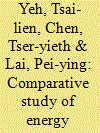

|
|
|
|
|
| Publication |
2010.
|
| Summary/Abstract |
This paper employs data envelopment analysis to evaluate energy utilization efficiency between China and Taiwan from 2002 to 2007. The most important contributions of this paper are the clear description of the systematic process of energy utilization efficiency, the efficiency comparison between China and Taiwan, the remarkable demonstration of their outputs through two non-desirable outputs (CO2 emissions and SO2 emissions) in the data envelopment analysis framework, and the valuable results and insights gained from the application of economic development and environmental protection. Empirical results show that the Eastern region of China enjoy higher energy utilization efficiency than the Western region. Energy utilization efficiency in Taiwan is higher than that in the Eastern region of China. In China, CO2 emissions were 11.28% greater than they should be (from 2002 to 2007). By contrast, CO2 emissions in Taiwan were only 1.50% in excess of what they should be since Taiwan began conducting an uninterrupted energy-saving policy and a CO2 emission regulation policy (Bureau of Energy, Ministry of Economic Affairs, 2009). Finally, this study employs the business strategy matrix constructed by the Boston Consulting Group (BCG Matrix) to illustrate individual evidence of the relationship between economic development efficiency and greenhouse gas efficiency.
|
|
|
|
|
|
|
|
|
|
|
|
|
|
|
|
| 15 |
ID:
094951
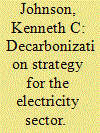

|
|
|
|
|
| Publication |
2010.
|
| Summary/Abstract |
An expedient phase-out of carbon emissions in the electricity sector could be facilitated by imposing carbon fees and applying the revenue exclusively to subsidize new, low-carbon generation sources. Since there would initially be no "new sources," fees would be substantially zero at the outset of the program. Nevertheless, the program would immediately create high price incentives for low-carbon capacity expansion. Fees would increase as new, low-carbon sources gain market share, but price competition from a growing, subsidized clean-energy industry would help maintain moderate retail electricity prices. Subsidies would automatically phase out as emitting sources become obsolete.
|
|
|
|
|
|
|
|
|
|
|
|
|
|
|
|
| 16 |
ID:
094931
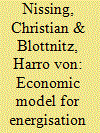

|
|
|
|
|
| Publication |
2010.
|
| Summary/Abstract |
It is widely recognised that access to and supply of modern energy play a key role in poverty alleviation and sustainable development. The emerging concept of energisation seems to capture this idea, and if implemented in its full complexity it should have multiple beneficial effects. To demonstrate this, an economic model is developed for an urban developmental context, drawing on the theory of urban ecosystems and illustrating energy and waste production and consumption issues with current South African data sets. This new understanding of the concept of energisation is then integrated into a local government energy planning process, by means of a checklist for energy planners, covering 18 aspects that between them affect all 7 identifiable tiers of the energy service supply network. A 6-step structured approach is proposed for integrating sustainable energisation into the first four phases of the advanced local energy planning (ALEP) tool.
|
|
|
|
|
|
|
|
|
|
|
|
|
|
|
|
| 17 |
ID:
094902


|
|
|
|
|
| Publication |
2010.
|
| Summary/Abstract |
Soon after the launching of the Camisea Gas Project, in 2000, Peru became a medium-range Latin American gas exporting country. Our central argument is that energy governance in this country has been shifting from a "hierarchical" to a "co-governance" mode. Accordingly, interactions among the State, the society and economic actors are now regulated in a horizontal and decentralized way, rather than a vertical and centralized one. This shift contributed to the success of the Camisea gas project and had a positive effect on foreign direct investments inflow in the energy sector (1). In addition, it has helped Peru reach energetic self-sufficiency, while improving its energy balance (2). Meanwhile, energy policy has welcomed a major participation of social actors, contributing to institutionalized arrangements between the State, the companies and indigenous communities and their NGO partners (3). Two theoretical conclusions can be drawn from this study. First, the State's role remains central in energy governance, thus invalidating the "hollowing of the State" thesis. Second, the co-governance mode helps to overcome the "resource curse" thesis.
|
|
|
|
|
|
|
|
|
|
|
|
|
|
|
|
| 18 |
ID:
094928


|
|
|
|
|
| Publication |
2010.
|
| Summary/Abstract |
China has set an ambitious target of increasing energy efficiency by 20% and reducing pollution discharges by 10% over the period 2006-2010. Promoting advanced technologies and closing outdated facilities are widely recognized as important measures to achieve these targets. These actions can also indirectly decrease release of polychlorinated dibenzo-p-dioxins (PCDDs) and polychlorinated dibenzofurans (PCDFs). The objectives of this paper are to identify and quantify reductions of PCDD/F emissions to air due to measures such as phasing out of obsolete facilities in the four most energy-intensive industrial sectors. Reductions in PCDD/F emissions from power generation were estimated to be 7, 33 and 38 g I-TEQ in 2006, 2007 and 2008, respectively. For the cement industry, reductions were estimated to be 680 g I-TEQ between 2007 and 2008, and 740 g I-TEQ between 2009 and 2010. For the iron and steel industry, the reduction was estimated to be 113.3 g I-TEQ over the period 2007-2010, which includes 76.6 g I-TEQ in 2007. For the coke industry, the reduction was estimated to be 68 g I-TEQ in 2007 and 62 g I-TEQ in 2008.
|
|
|
|
|
|
|
|
|
|
|
|
|
|
|
|
| 19 |
ID:
094886
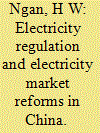

|
|
|
|
|
| Publication |
2010.
|
| Summary/Abstract |
The electricity industry of China has been in a process of reforms since the 1980s. This paper gives a review on the three main stages of reforms in China so as to trace out key features of various reform measures including those for power investment financing, the separation between government and power enterprises, and the division between power generation firms and power grids. The findings suggest that further regulatory change in China's electricity market reform is necessary when integration of the electricity markets and increased competition are paving the way ahead for a market-oriented structure. Prospective electricity regulation in the form of a strong legal system and effective institutions that protect market competition and promote appropriate incentives for efficiency are suggested in the paper.
|
|
|
|
|
|
|
|
|
|
|
|
|
|
|
|
| 20 |
ID:
094958


|
|
|
|
|
| Publication |
2010.
|
| Summary/Abstract |
The GHGs emmited by using conventional energy sources rapid industrialization and development in hills, are contributing global warming, which has resulted in melting of glaciers located in the state at the rate of 0.3-20 m2 per year as per recent studies. The shrinking of glaciers, which are the main source of water of Himalayan rivers, can have an adverse impact on the future of hydro-power projects, many of which may become non-functional during next 40-50 years if the current trend of melting of glaciers continues and the other renewable energy sources are required to be tapped to supplement the declining hydro-electricity generation. The energy consumption for cooking, lighting and space heating in the Western Himalayan Indian state of Himachal Pradesh, is highest in the northern India. The fuelwood consumption constitutes about 52% of the total energy consumption of the state. About 2.7 h per person per trip in the rural areas, are spent for the collection of fuelwood mainly during winters. A number of options and potential of renewable energy sources for cooking, heating and lighting in the state have been discussed. The future policy interventions in the energy sector are also presented.
|
|
|
|
|
|
|
|
|
|
|
|
|
|
|
|
|
|
|
|
|